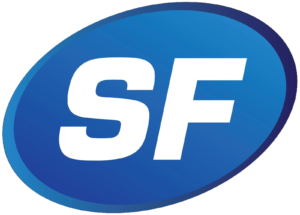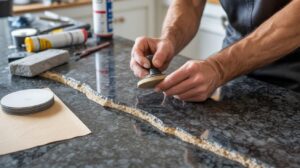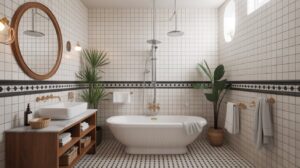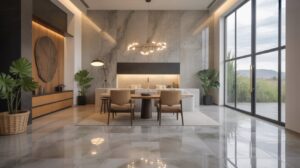Complete Guide to Travertine Restoration for Your Floors
Travertine floors add an exquisite touch to any space with their unique patterns and earthy tones. Over time, however, daily wear and tear can diminish their luster and shine. If you’re looking to restore the natural beauty of your travertine floors, you’re in the right place. In this guide, we’ll walk you through the process of travertine restoration, addressing common concerns and providing expert advice to help you revitalize your floors. As you embark on your travertine restoration journey, consider the expertise of SF Marble and Granite Inc. Our dedicated team is committed to bringing back the timeless elegance of your floors.

Travertine restoration is not just about aesthetics; it’s about preserving the lifespan of your flooring. Without proper maintenance and care, travertine can lose its shine and become vulnerable to damage. Restoration brings back the original elegance of the stone while enhancing its durability.
Table of Contents
ToggleUnderstanding the Significance of Travertine Restoration
Travertine restoration is not just about aesthetics; it’s about preserving the lifespan of your flooring. Without proper maintenance and care, travertine can lose its shine and become vulnerable to damage. Restoration brings back the original elegance of the stone while enhancing its durability.
Step-by-Step Guide to Restoring Your Travertine Floors
Assessment and Preparation: Setting the Stage for Restoration
Before embarking on the restoration journey, evaluate the condition of your floors. Identify areas with scratches, cracks, or stains. Clear the area and ensure you have the necessary tools and materials for the process.
Gentle Cleaning Techniques: Nurturing Your Travertine
Start by gently removing dirt and debris from the surface. Use a pH-neutral stone cleaner and a soft mop or cloth. Avoid acidic or abrasive cleaners that can harm the stone. Thoroughly rinse the floor to prevent residue buildup.
Repairing Scratches and Cracks: A Flawless Surface
For minor scratches, consider using a fine-grit sandpaper or a specialized travertine repair kit. Deeper cracks may require professional attention. Fill the cracks with a color-matched epoxy resin and allow it to cure.
Polishing and Honing: Restoring the Lustrous Shine
Polishing and honing bring back the glossy finish of your travertine floors. Use a low-grit diamond polishing pad for honing, followed by a higher-grit pad for polishing. Work in small sections and keep the surface wet.
Sealing for Longevity: Protecting Your Investment
Sealing your travertine floors is crucial to prevent future damage. Choose a penetrating sealer that provides a barrier against moisture and stains. Apply the sealer evenly and allow it to dry completely.
Types of Travertine Damage and How to Avoid Them
Travertine is a stunning, natural stone that can elevate the beauty of any space. However, like all natural stones, it requires proper care to maintain its elegance and longevity. Without proper attention, travertine can be prone to certain types of damage. Here’s a closer look at some of the most common issues that can affect travertine, and how to prevent them.
1. Etching: The Silent Damage from Acidic Substances
Etching is one of the most common forms of damage to travertine and occurs when acidic substances come into contact with the surface. Spilling things like lemon juice, vinegar, wine, or cleaning products containing acid can result in dull, matte spots that strip away the shine of the stone.
How to Prevent It:
- Wipe up spills immediately, especially acidic substances.
- Use coasters, placemats, or trays for items that might contain acids.
- Clean with neutral pH stone cleaners designed for travertine.
2. Staining: The Result of Oil and Grease Buildup
Stains on travertine can happen for several reasons, but the most common culprits are oils, grease, and food-related liquids. These stains are typically caused by thick water, greasy food, or even burnt-on food after scrubbing. The porous nature of travertine makes it highly susceptible to absorbing these substances, which can leave unsightly marks.
How to Prevent It:
- Seal your travertine to create a protective layer that resists stains.
- Clean up spills promptly and thoroughly.
- Avoid placing greasy or oily items directly on the surface.
3. Discoloration and Dullness: The Results of Overzealous Cleaning
Cleaning is essential, but when done too aggressively, it can cause microscopic scratches on the surface of your travertine. These tiny scratches can lead to discoloration or a dull, faded appearance. Using harsh cleaners or abrasive tools can also strip the stone’s natural shine, making it look worn.
How to Prevent It:
- Avoid using abrasive scrubbers or acidic cleaners.
- Use a soft cloth or mop and a pH-neutral stone cleaner.
- Clean gently to avoid dulling the surface and causing long-term damage.
4. Chips & Scratches: The Consequences of Rough Handling
Travertine, while durable, can be chipped or scratched if handled improperly. Dropping heavy items or dragging furniture across the floor can leave noticeable marks or break parts of the stone. These imperfections can ruin the stone’s smooth, elegant finish.
How to Prevent It:
- Be mindful when moving furniture or heavy objects.
- Consider using felt pads under furniture legs to protect the floor.
- Handle tiles carefully during installation or renovation.
5. Cracks: A Sign of Improper Installation
Cracks in travertine are usually a result of improper installation. If the tiles weren’t set correctly or the subfloor wasn’t properly prepared, the stone can shift and crack under pressure. Uneven surfaces or poor-quality adhesive can contribute to this problem.
How to Prevent It:
- Ensure professional installation by experienced experts.
- Verify that the subfloor is level and solid before installing travertine.
- Use high-quality adhesive designed specifically for travertine.
The Art of Fixing Scratched Travertine Tile: DIY Tips and Tricks
Accidents happen, and scratches on your beloved travertine tiles can be disheartening. Fortunately, there are several DIY methods that you can try before considering professional intervention. These simple yet effective tips and tricks allow you to address minor scratches and restore the allure of your travertine floors without breaking the bank.
Baking Soda Magic
One popular and gentle method involves the use of baking soda. Create a paste by mixing baking soda with water until it forms a thick consistency. Apply the paste directly to the scratched area and use a soft cloth to gently buff the surface in a circular motion. This mild abrasive action helps diminish the appearance of minor scratches and scuffs.
Vegetable Oil Elixir
Believe it or not, common vegetable oil can come to the rescue for minor scratches. Apply a small amount of vegetable oil to a clean, soft cloth and rub it onto the scratched tile. The oil helps fill in the scratch and minimize its visibility, giving your travertine a renewed and smoother appearance.
Talcum Powder Touch-Up
For shallower scratches, talcum powder can work wonders. Mix a small amount of talcum powder with water to create a paste. Apply the paste to the scratched area, ensuring it fills the groove. Allow the paste to dry, and then gently buff it away with a soft cloth. The talcum powder acts as a filler, reducing the scratch’s prominence.
Clear Nail Polish Trick
Clear nail polish is not just for your nails; it can also be a handy solution for minor travertine scratches. Apply a thin layer of clear nail polish to the scratched tile, ensuring it covers the entire affected area. Allow the polish to dry completely before gently sanding the surface with fine-grit sandpaper. This method helps level the scratch and restore a smoother texture.
Magic Eraser Marvel
A magic eraser is a versatile tool that can work wonders on small scratches. Dampen the magic eraser and gently rub it over the scratched tile. The eraser’s micro-abrasive texture helps buff away minor imperfections. Remember to test a small, inconspicuous area first to ensure it doesn’t affect the finish of the tile.
Vinegar and Water Solution
For a natural and eco-friendly solution, mix equal parts white vinegar and water in a spray bottle. Lightly spray the solution onto the scratched tile and let it sit for a few minutes. Gently scrub the area with a soft cloth or sponge, then rinse with clean water. The mild acidity of vinegar helps to reduce the visibility of minor scratches.
Remember, while these DIY methods can be effective for minor scratches, deeper or more extensive damage may require the expertise of a professional. If you’re unsure about the severity of the scratches or want to ensure the best results, it’s always a good idea to consult with a travertine restoration specialist.
Travertine Restoration Costs: Budgeting for Elegance
Investing in the restoration of your travertine floors not only rejuvenates their appearance but also adds a touch of timeless elegance to your space. However, understanding the costs involved is essential for effective budgeting and ensuring that the beauty of your floors is restored without financial strain. Let’s delve into the intricacies of travertine restoration costs, factors that influence the pricing, and tips to make the most of your budget.
Factors Influencing Restoration Costs
- Extent of Damage: The severity of scratches, cracks, and stains on your travertine floors plays a significant role in determining the overall cost. Minor imperfections may only require polishing and sealing, while deep scratches or cracks necessitate more extensive repair work.
- Size of the Area: The square footage of the area to be restored directly affects the cost. Larger spaces require more time, labor, and materials, contributing to higher restoration expenses.
- Type of Restoration: Different levels of restoration, such as light polishing, honing, crack repair, and sealing, come with varying costs. Assessing the specific needs of your floors helps determine the appropriate level of restoration.
- Labor and Professional Expertise: Hiring skilled professionals ensures high-quality restoration results but comes with associated labor costs. The experience and reputation of the restoration service provider can also influence pricing.
- Location: Restoration costs can vary based on your geographical location and local market rates. Urban areas and regions with higher living costs may have slightly elevated pricing.
Budget-Friendly Restoration Tips
- Regular Maintenance: Implementing a consistent maintenance routine can help prevent extensive damage and reduce the need for frequent and costly restoration. Sweep, mop, and clean spills promptly to preserve your travertine floors’ condition.
- Address Issues Promptly: Attend to minor scratches and stains as they occur. Swift action can prevent them from worsening, ultimately saving you from more extensive and expensive restoration work in the future.
- Get Multiple Quotes: When considering professional restoration services, obtain quotes from different providers. This allows you to compare pricing, services offered, and customer reviews to make an informed decision.
- DIY Options: For minor scratches and light wear, consider utilizing DIY methods to restore your travertine floors. These cost-effective techniques can help maintain your floors’ appearance without significant expenses.
- Combine Restoration with Other Upgrades: If you’re planning other home improvements, such as painting or remodeling, consider coordinating the timing of your travertine restoration. Combining projects can potentially save on labor and disruption costs.
Embracing the Investment
While travertine restoration comes with a cost, it’s essential to view it as an investment rather than an expense. Restored travertine floors not only enhance the aesthetic appeal of your home but also contribute to its overall value. The elegance, durability, and uniqueness of travertine make it a sought-after feature for potential buyers or tenants.
Maintaining Your Restored Travertine Floors: Dos and Don’ts
After restoration, proper maintenance is key to prolonging the beauty of your travertine floors. Do use coasters under furniture legs and quickly clean up spills. Don’t use harsh chemicals or abrasive cleaners, as they can strip away the sealer and damage the stone.
Renew the Elegance of Travertine Floors with Our Marble Floor Installation Service in Lowell
At SF Marble and Granite Inc., we don’t just install brand-new marble floors we also help homeowners maintain and restore the elegance of natural stone surfaces like travertine. If your travertine flooring has lost its shine, shows signs of wear, or suffers from scratches and cracks, our team offers expert guidance and hands-on service to bring it back to life.
Our marble floor installation in Lowell service often includes tailored solutions for existing stone surfaces, including travertine polishing, sealing, and refinishing. Whether it’s part of a new installation or a complete floor restoration project, we bring more than a decade of experience in working with all types of natural stones. We use industry-leading tools and sealants to restore the luster of your travertine tiles while also protecting them from future damage.
Choosing us means you’ll get the same quality and precision whether we’re installing a brand-new marble floor or reviving an old travertine one. We understand that every stone tells a story and we’re here to preserve it.
Conclusion
Travertine restoration is a transformative process that unveils the inherent beauty of the stone. By following the steps outlined in this guide, you can enjoy stunning, revitalized floors that enhance the aesthetic and value of your space. Embrace the elegance of your restored travertine floors and relish in their timeless charm.
As you set out on your quest for travertine restoration, take advantage of SF Marble and Granite Inc.’s wealth of expertise. Our team is devoted to reviving the ageless splendor of your floors. Explore the details of our all-inclusive restoration services and unveil the remarkable metamorphosis that awaits your living space. Contact us today.
FAQs
How often should I consider restoring my travertine floors?
The frequency of restoration depends on factors like foot traffic and maintenance. Generally, considering restoration every 3 to 5 years is a good guideline.
Can I restore my travertine floors without professional help?
While some minor issues can be addressed through DIY methods, professional restoration ensures a thorough and lasting outcome.
What factors contribute to the cost of travertine restoration?
The extent of damage, the size of the area, and the complexity of the restoration process influence the overall cost.
Are there any eco-friendly restoration options for travertine floors?
Yes, there are environmentally friendly sealers and restoration products available that prioritize sustainability.
Is it possible to prevent scratches on travertine floors?
Taking preventive measures like using furniture pads and avoiding abrasive materials can significantly reduce the risk of scratches.
Contact Us







